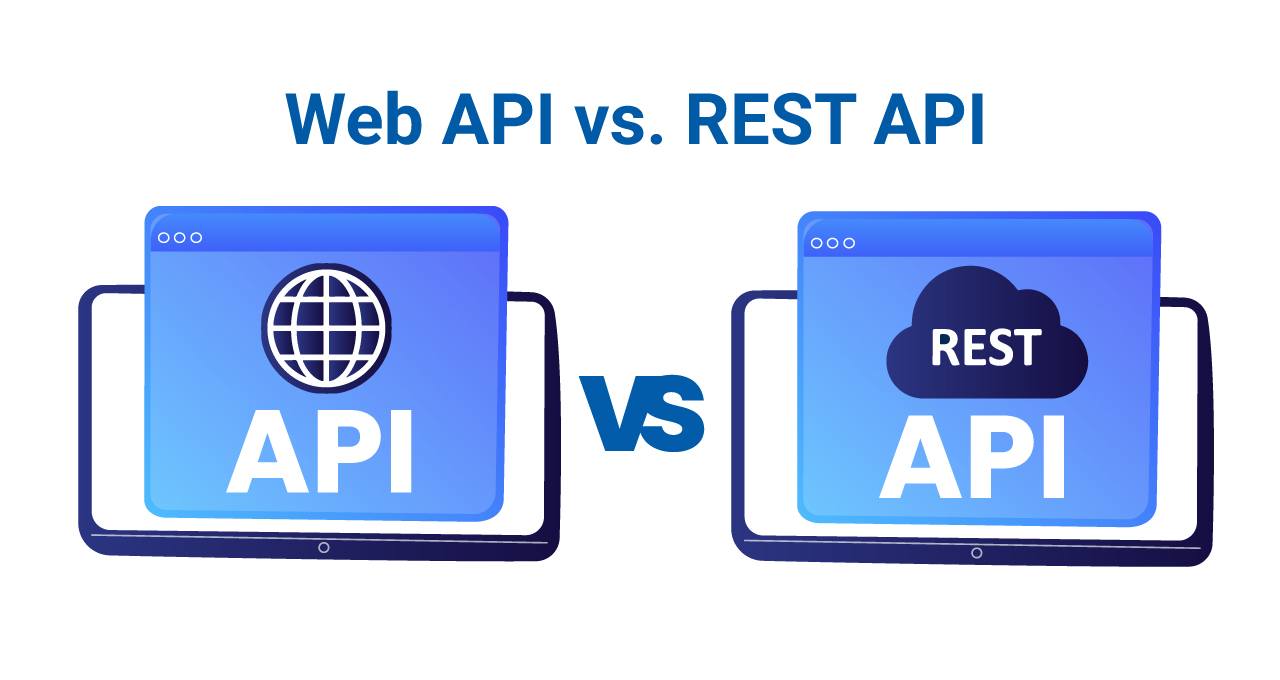
APIs allow data to flow from one platform to another seamlessly and play an integral part in software development. The terms "REST API" and "Web API" are often used interchangeably, and they both allow developers to interact with web services. However, there are some key differences between the two.
Web API
A web API (Application Programming Interface) is a term that refers to an interface exposed over the web that allows different software applications to communicate with each other. It provides a set of rules and protocols that enable interaction between various software systems, often using HTTP (Hypertext Transfer Protocol) as the underlying communication protocol. Web APIs can take different forms, such as SOAP (Simple Object Access Protocol), XML-RPC, or JSON-RPC, and they may not strictly adhere to the principles of Representational State Transfer (REST).
REST API
REST (Representational State Transfer) is a specific architectural style for designing scalable applications. A RESTful API follows a set of principles and constraints, which include using standard HTTP methods (GET, POST, PUT, DELETE) to perform operations on resources, utilizing unique resource identifiers (URIs) to address resources, and employing stateless communication.
REST APIs are typically designed to be lightweight, scalable, and easy to consume. They often use JSON or XML as the data format for request and response payloads.
While a web API refers to any interface exposed over the web for application communication, a REST API specifically adheres to the principles and constraints of the REST architectural style. RESTful APIs have gained popularity due to their simplicity, scalability, and compatibility with the web, but not all web APIs are necessarily RESTful. A good example of RESTful API is the API provided by IP Location on our website.
What are the similarities between web API and REST API?
The two APIs share several similarities, and they are as follows:
- Communication over the web: Both web APIs and REST APIs are accessed over the web. They enable communication between different software systems, allowing them to exchange data and perform operations.
- HTTP as the underlying protocol: Both web APIs and REST APIs commonly utilize the HTTP protocol for communication. This includes using standard HTTP methods like GET, POST, PUT, DELETE to perform operations on resources.
- Data formats: Both types of APIs often use widely supported data formats such as JSON or XML to structure the data in the request and response payloads.
- Resource-based approach: Both web APIs and REST APIs typically adopt a resource-based approach, where resources (e.g., objects, entities, or data) are exposed and accessed through URIs (Uniform Resource Identifiers). Clients interact with these resources by making requests to the appropriate URIs.
- Interoperability: Both web APIs and REST APIs promote interoperability between different systems and programming languages. They provide a standardized way for software applications to communicate, making it easier to integrate and connect disparate systems.
Web APIs may use different protocols or data formats, while REST APIs specifically follow the principles and constraints of the REST architectural style.
What are the differences between Web API and REST API?
There are several key differences between the two APIs, and they are as follows:
- Architectural style: REST APIs adhere to the principles and constraints of the REST architectural style, which emphasizes a stateless, client-server communication model. Web APIs do not necessarily adhere to REST principles and can utilize different architectural styles, such as SOAP or XML-RPC.
- Uniform interface: REST APIs have a standardized and uniform interface, utilizing HTTP methods (GET, POST, PUT, DELETE) for operations on resources and using URIs to address resources. Web APIs may have more varied interfaces and may use different protocols or mechanisms for accessing and manipulating data.
- Data format: While both web APIs and REST APIs commonly use JSON or XML for data exchange, web APIs may also use other formats such as SOAP (Simple Object Access Protocol).
- Constraints and constraints compliance: REST APIs strictly adhere to the constraints of the REST architectural style, such as statelessness, cacheability, and a uniform interface. Web APIs may not conform to these constraints and can have more flexibility in terms of their design and implementation.
- Scalability and simplicity: REST APIs are known for their scalability and simplicity. They are lightweight and straightforward to consume due to their uniform interface and stateless nature. Web APIs can vary in terms of their complexity and scalability, depending on the chosen architectural style and implementation choices.
- Industry adoption: REST APIs have gained significant popularity and widespread adoption due to their simplicity, scalability, and compatibility with the web. Web APIs encompass various types of APIs with different architectural styles, making it difficult to determine their overall industry adoption.
The term "web API" is often used more generally and can encompass APIs that do not strictly adhere to REST principles. REST APIs are a specific subset of web APIs that follow the principles of the REST architectural style.
Benefits of offering APIs
Offering APIs can bring several benefits for businesses and developers. Here are some of the key advantages:
- Integration and Interoperability: APIs enable seamless integration between different software systems, platforms, and services. They allow developers to connect their applications with external systems, databases, or services, enabling data exchange and functionality sharing. This promotes interoperability and enables the development of complex, interconnected ecosystems.
- Expand Reach and User Base: By offering APIs, businesses can attract developers and third-party organizations to build applications, products, or services that integrate with their platform. This can lead to an extended reach and a larger user base. APIs act as a gateway for others to leverage your core functionality, which can increase your brand visibility and attract new customers.
- Innovation and Collaboration: APIs encourage innovation by enabling developers to leverage existing resources and build new applications on top of them. By exposing certain functionalities or data through APIs, businesses can foster collaboration, leading to the development of new features, products, or services that the business may not have the resources to build their own.
- Developer Community and Ecosystem: APIs can help foster a thriving developer community around your platform. By providing comprehensive documentation, developer resources, and support, you can attract developers who are interested in integrating with your products. This community can contribute to the growth of your ecosystem, offer valuable feedback, and even provide enhancements to your core products.
- Monetization Opportunities: APIs can serve as a revenue stream by providing access to premium features, data, or services through a paid API service. Businesses can charge developers for API usage, based on metrics like API calls, data transfer, or specific functionalities. This monetization model can generate additional income and drive business growth.
- Improved User Experience: APIs allow businesses to create a more seamless user experience by integrating third-party services or functionalities into their own applications. This can enhance the overall value proposition and provide users with additional features, data, or services, all within a unified interface. It enables businesses to leverage external expertise and focus on their core strengths while delivering a more comprehensive solution to users.
- Rapid Development and Time-to-Market: APIs can expedite application development by providing pre-built functionality or services. Developers can leverage APIs to save time and effort, rather than building everything from scratch. This can significantly reduce development lifecycles and time to market for new applications, enabling businesses to stay competitive in a fast-paced market.
Offering APIs empowers businesses to extend their reach, foster innovation, collaborate with external developers, and create value-added experiences for their users. It can unlock new business opportunities, drive growth, and facilitate the development of a vibrant ecosystem around your products or services.
Conclusion
While there are similarities between web APIs and REST APIs, there are also notable differences. Both web APIs and REST APIs facilitate communication over the web and use HTTP as the underlying protocol. They enable interoperability between software systems and often utilize JSON or XML as data formats for data exchanges.
REST APIs strictly adhere to the principles and constraints of the REST architectural style, emphasizing a uniform interface, resource-based approach, and statelessness. Web APIs encompass a broader range of APIs and can employ different architectural styles such as SOAP or XML-RPC, offering more flexibility but potentially sacrificing the simplicity and scalability provided by REST. Understanding these differences helps in choosing the appropriate API design approach based on the specific requirements of your project.
Share this post
Leave a comment
All comments are moderated. Spammy and bot submitted comments are deleted. Please submit the comments that are helpful to others, and we'll approve your comments. A comment that includes outbound link will only be approved if the content is relevant to the topic, and has some value to our readers.




Comments (0)
No comment